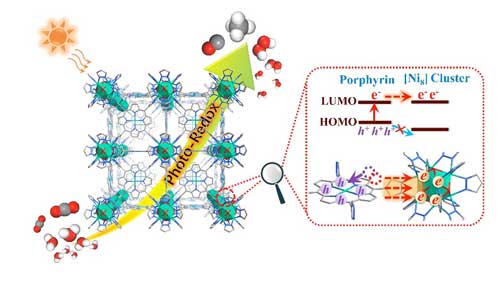| Jul 31, 2020 | |
Efficient and durable overall CO2 photoreduction achieved by rationally designed MOFs(Nanowerk News) ZrOx cluster nodes and carboxylate ligands are the most adopted units to construct stable metal-organic framework (MOF) photocatalysts, which induce high energy barriers for reactants activation on metal nodes and hamper the charge transfer at ligand/node interfaces. |
|
| Conversely, MOFs consisted of carboxylate ligands and catalytically reactive metal elements (e.g. Co, Ni, Cu) are structurally unstable in photocatalytic conditions. | |
| Moreover, the uneconomical hole scavengers are commonly used in current systems to unilaterally attain high activities for the multielectron-involved CO2 reduction half-reaction, which also confines the reactions in liquid phase sacrificing the high gas uptakes of MOFs. | |
| In a study published in J. Am. Chem. Soc. ("Boosting Interfacial Charge-Transfer Kinetics for Efficient Overall CO2 Photoreduction via Rational Design of Coordination Spheres on Metal–Organic Frameworks"), a research group led by Prof. CAO Rong from Fujian Institute of Research on the Structure of Matter (FJIRSM) of the Chinese Academy of Sciences selected a MOF (denoted as PCN-601) composed of reactive NiOx cluster nodes and light-harvesting metalloporphyrin ligands connected via pyrazolyl groups as a sole photocatalyst and achieved efficient and durable gas-phase overall CO2 photoreduction with H2O vapor. | |
 |
|
| Scheme of the photocatalytic overall CO2 reduction by PCN-601 and the proposed charge-transfer mechanism at ligand/node interface. (Image: Dr. FANG Zhibin) (click on image to enlarge) | |
| The researchers avoided the use of hole scavengers and took full advantage of the high gas uptake of MOFs. The CO2-to-CH4 production rates were among the state-of-the-art cases for room-temperature overall CO2 photoreduction. | |
| The mechanism study explored the thermodynamically feasible charge-transfer pathways within PCN-601, and the kinetic aspects including charge-transfer efficiency and reactant affinities on the coordination sphere were then analyzed. | |
| Combining theoretical and experimental results, the researchers found that the pyrazolyl-NiOx coordination sphere endowed PCN-601 with robust stability and, more importantly, the capability of ultrafast ligand-to-node electron transfer as well as facilitated CO2 and H2O adsorption and activation, leading to greatly promoted photocatalytic kinetics compared with the analogous porphyrin MOFs with carboxyl-ZrOx coordination sphere. | |
| This study demonstrates that the rational design of coordination spheres reconciles the contradiction between reactivity and stability of MOFs, which is anticipated to provide significant guidance for the design of highly efficient photocatalysts. |
| Source: Chinese Academy of Sciences | |
|
Subscribe to a free copy of one of our daily Nanowerk Newsletter Email Digests with a compilation of all of the day's news. |
